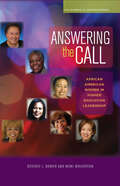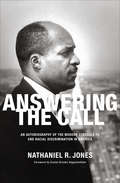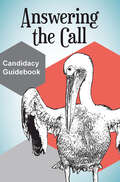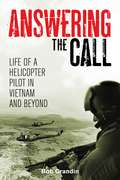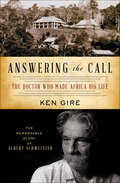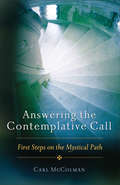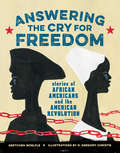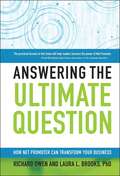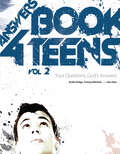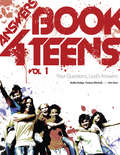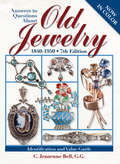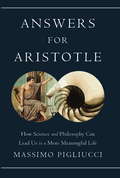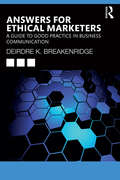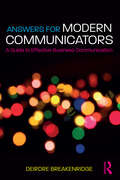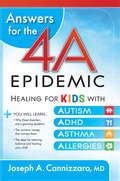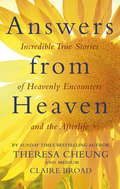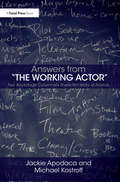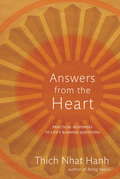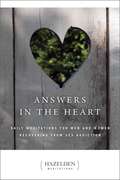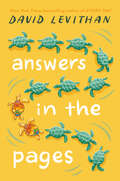- Table View
- List View
Answering the Call: African American Women in Higher Education Leadership
by Mimi Wolverton Beverly L. BowerAlthough much has been written about leaders and leadership, we unfortunately know little about women, particularly minority women, who fill this particular role. This book presents the stories, and the reflections on their paths to leadership in higher education, of seven African American women. Each has been the first woman, first African American, or first African American woman in one or more of the positions of authority that she has held. Each has overcome the double bind of sexism and racism that can inhibit the professional attainment of African American women. Although they followed different paths to leadership, similarities in their experiences, values, and beliefs emerge. They also express a need to give back to those communities that nourished their growth and leadership – of which this book is a manifestation. At a time when significant turnover in college leadership is about to occur – presenting increased opportunities for women and minorities – these leaders hope that the strategies they describe, the insights they impart, the experiences they recount, and, most of all, the passion they have sustained for the betterment of and greater inclusiveness in higher education, will inspire the next generation of women to answer the leadership call.
Answering the Call: An Autobiography of the Modern Struggle to End Racial Discrimination in America
by Nathaniel R. Jones&“Jones, a trailblazing African American judge, delivers an urgently needed perspective on American history . . . [A] passionate and informative account&” (Booklist, starred review). Answering the Call is an extraordinary eyewitness account from an unsung hero of the battle for racial equality in America—a battle that, far from ending with the great victories of the civil rights era, saw some of its signal achievements in the desegregation fights of the 1970s and its most notable setbacks in the affirmative action debates that continue into the present in Ferguson, Baltimore, and beyond. Judge Nathaniel R. Jones&’s groundbreaking career was forged in the 1960s: As the first African American assistant US attorney in Ohio; as assistant general counsel of the Kerner Commission; and, beginning in 1969, as general counsel of the NAACP. In that latter role, Jones coordinated attacks against Northern school segregation—a vital, divisive, and poorly understood chapter in the movement for equality—twice arguing in the pivotal US Supreme Court case Bradley v. Milliken, which addressed school desegregation in Detroit. He also led the national response to the attacks against affirmative action, spearheading and arguing many of the signal legal cases of that effort. Answering the Call is &“a stunning, inside story of the contemporary struggle for civil rights . . . Essential reading for understanding where we are today—underscoring just how much work is left to be done&” (Vernon E. Jordan Jr., civil rights activist). &“A forthright testimony by a witness to history.&” —Kirkus Reviews
Answering the Call: Candidacy Guidebook
by Abingdon PressHow to prepare for ordination in The United Methodist Church.Discover your true purpose and gain clarity in your spiritual calling with Answering the Call, the Candidacy Guidebook from the General Board of Higher Education and Ministry. Thoughtfully designed to inspire deep reflection, this guide walks you through the essential steps to discern whether ordained ministry aligns with God's plan for your life.It’s not just about hearing the call; it’s about understanding whether your unique gifts, grace, and readiness align with the path of ministry leadership. Packed with prayerful guidance and thought-provoking questions, this resource empowers you to make a faithful decision, not just for yourself, but for the community you are called to serve.Whether you’re stepping into this process with excitement or uncertainty, Answering the Call offers the counsel and reassurance you need. Required reading for those pursuing candidacy within the United Methodist Church, this guidebook invites you to explore your potential with confidence, ensuring that God’s purpose can work powerfully through your life, no matter the outcome.
Answering the Call: Life of a Helicopter Pilot in Vietnam
by Bob GrandinIn 1966, Bob Grandin was a Royal Australian Airforce helicopter pilot stationed in Vietnam. This book is written from the logbook he kept while working in Nui Dat and is a fascinating look at life during war – the dangers, the challenges and the mundaneness. On 18 August he was co-pilot on a 9 Squadron Iroquois &‘Huey&’ helicopter that flew over the enemy to resupply desperate solders engaged in battle at the Long Tan rubber plantation. Enduring extremely poor weather conditions and enemy fire the critical role played by Bob and 9 Squadron in the Battle of Long Tan contributed to the success of this battle. The narrative of his war experiences are interwoven with stories of his life after Vietnam, revealing the difficulties he faced back home, the impact of the war on his psyche and relationships, and his struggles with PTSD. A collection of Australian newspaper articles saved by Bob&’s father feature throughout, giving further insight into how important helicopters were in Vietnam, and also how the press reported the war to the Australian public. Answering the Call provides the unique perspective of a wartime helicopter pilot and is an important addition to Vietnam War history.
Answering the Call: The Doctor Who Made Africa His Life: The Remarkable Story of Albert Schweitzer
by Ken GireA Christian author’s inspiring biography of the Nobel Peace Prize–winning theologian and physician who built a hospital in French Equatorial Africa.As a young man, Albert Schweitzer seemed destined for greatness. His immense talent and fortitude drove him to become one of twentieth century Europe’s most renowned philosophers, theologians, and musicians. Yet Schweitzer shocked his contemporaries by forsaking worldly success and embarking on an epic journey into the wilds of French Equatorial Africa, vowing to serve as a lifelong physician to “the least of these” in a land rife with famine, sickness, and superstition.Schweitzer was honored with a Nobel Peace Prize in 1952. His legacy endures in the thriving African hospital community that began in a chicken coop, the millions who have drawn inspiration from his example, and the timeless wisdom and compassion of his writings. In this vividly narrated biography, Ken Gire sheds new light on Schweitzer’s faith-in-action ethic and his commitment to honor God by celebrating the sacredness of all life.
Answering the Contemplative Call: First Steps on the Mystical Path
by Carl McColmanThe mystical path is not some sort of static experience for the select few, says Carl McColman, rather, it is a living tradition, a rich and many-layered dimension of spirituality that is in large measure a quest to find the mysteries at the heart of the universe, paradoxically nestled within the heart of your own soul. <P><P>McColman first introduced readers to Christianity&’s lost mystical roots in his popular book, The Big Book of Christian Mysticism. Now McColman is back with Answering the Contemplative Call, to show readers how to apply the riches of the mystical tradition to daily living. <P><P>This book is organized in three sections: <P><P>“Recognizing the Call” Explores how each one of us is called to the mystical life, and what that might look like. <P><P>“Preparing for the Journey” shows what we need to do in response to the contemplative call. <P><P>“Embarking on the Adventure” considers what those first steps on the path might look like. <P><P>Along the way McColman quotes from the great mystics of the Christian tradition who have also traveled this path, including Teresa of Avila, Thomas Merton, Evelyn Underhill and more.In Answering the Contemplative Call, McColman offers a practice that will help readers come to a place meaning and purpose in their lives.
Answering the Cry for Freedom: Stories Of African Americans And The American Revolution
by R. Gregory Christie Gretchen WoelfleEven as American Patriots fought for independence from British rule during the Revolutionary War, oppressive conditions remained in place for the thousands of enslaved and free African Americans living in this country. <P><P>But African Americans took up their own fight for freedom by joining the British and American armies; preaching, speaking out, and writing about the evils of slavery; and establishing settlements in Nova Scotia and Africa. The thirteen stories featured in this collection spotlight charismatic individuals who answered the cry for freedom, focusing on the choices they made and how they changed America both then and now. Includes individual bibliographies and timelines, author note, and source notes.
Answering the Ultimate Question
by Richard Brooks Laura L. OwenFred Reichheld's 2006 book The Ultimate Question, that question being, "How likely is it that you would recommend this company to a friend or colleague?"-challenged the conventional wisdom of customer satisfaction programs. It coined the terms 'bad profits' and 'good profits' and pointed to a faster, much more accurate way of gauging customers' real loyalty to a company, introducing a quantitative measure (the Net Promoter Score) for establishing a baseline and effectively tracking changes going forward. Richard Owen and Laura Brooks are co-developers, along with Reichheld, of the methodology behind answering the question. In this book, Owen and Brooks tell how based on a variety of real case studies' to actually embed Net Promoter discipline in organizations of all types.
Answers Book For Teens Volume 2
by Ken Ham Bodie Hodge Dr Tommy MitchellTeens have big life questions and demand solid answers. Our youth are on the front lines of a war of the worldviews. To help them cement a biblical worldview, the experts at Answers in Genesis offer the Answers Books for Teens, volumes 1 and 2. In volume 2, teens will find answers to 15 questions relevant to today's culture including: Don't fossils prove evolution? What about abortion, cloning, and stem cells? These things are good for society right? Did creation really take just 6 days or did God use the big bang? How can we be sure the 66 books of the Bible are the only ones from God? Answers to these issues are paired with dynamic designs created to appeal to today's student. This 96 page book makes a great study for youth ministries, small groups, and family devotions. It will be an excellent reference for church and family libraries.
Answers Book for Teens Volume 1
by Ken Ham Bodie Hodge Dr Tommy MitchellThere's no mistake...God is seeking you. Friends, teachers, and the world in general will tell you that Christianity and faith is a lie. Atheism and Eastern religions are more fashionable. The culture tells you to look and act certain ways or people will think you're a loser or weird. If you say you believe in God, you can expect people to be in your face, doing their best to tear down God, the Bible, and your belief in Christ. By now, you may even have a few doubts - everything seems so crazy and pointless, how can you believe God really does care about what is going on with you? Or if God is in charge of this chaos called life? You aren't the only one with questions! Find great answers to 15 popular faith questions and discover why the world is such a mess, why you can believe in Christ, and why God wants a relationship with you! For ages 13 to 17
Answers To Questions About Old Jewelry
by C Jeanenne BellMake smart sense of today's dynamic world of collectible jewelry when you rely on the answers to key questions about vintage jewelry covered in this new full-color edition of the jewelry collector's classic must-have. Authoritative details, such as maker's marks, outlined in this guide help collectors and dealers identify, date and assess everything from brooches and pins and pendants, rings and lockets of the mid-1800s through the 1950s. This new color edition also includes coverage of Modernist jewelry; as well as an expanded section devoted to Mexican jewelry, a market where many pieces are selling for thousands of dollars each.
Answers for Aristotle: How Science and Philosophy Can Lead Us to A More Meaningful Life
by Massimo PigliucciHow should we live? According to philosopher and biologist Massimo Pigliucci, the greatest guidance to this essential question lies in combining the wisdom of 24 centuries of philosophy with the latest research from 21st century science. In Answers for Aristotle, Pigliucci argues that the combination of science and philosophy first pioneered by Aristotle offers us the best possible tool for understanding the world and ourselves. As Aristotle knew, each mode of thought has the power to clarify the other: science provides facts, and philosophy helps us reflect on the values with which to assess them. But over the centuries, the two have become uncoupled, leaving us with questions—about morality, love, friendship, justice, and politics—that neither field could fully answer on its own. Pigliucci argues that only by rejoining each other can modern science and philosophy reach their full potential, while we harness them to help us reach ours. Pigliucci discusses such essential issues as how to tell right from wrong, the nature of love and friendship, and whether we can really ever know ourselves—all in service of helping us find our path to the best possible life. Combining the two most powerful intellectual traditions in history, Answers for Aristotle is a remarkable guide to discovering what really matters and why.
Answers for Ethical Marketers: A Guide to Good Practice in Business Communication
by Deirdre K. BreakenridgeWith recent changes in technology, media, and the communication landscape, the journey to ethics has become more complicated than ever before. This book aims to answer ethical questions, from applying ethics and sound judgment through your organization and communication channels to taking your ethics and values into every media interview. With the understanding of how personal and professional ethics align, business leaders, managers, and students will maneuver their way around this new landscape showcasing their values in ethical conduct. This book is divided into eight important areas based on where and why a breakdown in ethical behavior is likely to occur, and delivers advice from experts on the frontlines of business communications who know what it means to face the inherent changes and challenges in this field. With more than 80 questions and answers focused on guiding marketing, PR and business professionals, readers will uncover situations where ethics are challenged, and their values will be tested. This straightforward Q&A guidebook is for professionals who realize ethics are a crucial part of decision-making in their communications and who want to maintain trust with the public and their positive brand reputations in business. Readers will receive answers to pressing ethical questions to help them apply best practice guidelines and good judgment in their own situations, based on the stories, theories, and practical instruction from the author’s 30 years of experience as well as the thought leaders featured in this book.
Answers for Homeschooling: Top 25 Questions Critics Ask
by Israel WayneYou’ve made the decision to homeschool. Suddenly, you find that some of those who were once in your corner supporting you are now questioning your competency as a parent and maybe even your sanity. Their lack of confidence may sting, but in reality, the critic provides a wonderful opportunity to replace fear and stigma with truth and reality. This book equips you to answer the critic in your life with resolve and confidence. ANSWERS to help you become confident in your homeschooling journey! Socialization Qualifications College Legality Academics Sports Affordability Competency
Answers for Modern Communicators: A Guide to Effective Business Communication
by Deirdre BreakenridgeThis book provides students and professionals with practical answers to important career and communication questions, helping them to communicate successfully in a business setting. Communication expert, Deirdre Breakenridge, examines the ways in which professionals can make the most of their careers in a fast-changing media landscape, offering advice on how new and seasoned executives can utilize and adapt to the latest modes of communication. The author breaks down the eight most critical areas for professionals seeking to develop their communication skills, opening with essentials that will prove useful in any setting. She then details the ways in which organizations can adapt to changes in technology and consumer behavior to improve relationships, social media presence, and brand recognition. The easy to follow question–answer format walks readers through the most pressing, confusing, and frequently asked questions about successful communication with plenty of advice and examples for a better learning experience. Covering traditional business communication topics like partnerships and storytelling, the book also includes material on digital and social media channels as well as a chapter on giving back as a mentor. "Experts Weigh In" boxes feature advice from other top professionals, exposing the reader to multiple perspectives from the field. Grounded in decades of experience, Answers for Modern Communicators will benefit all students getting ready to enter the workforce as well as professionals looking to enhance their communication skills.
Answers for the 4-A Epidemic: Healing for Kids with Autism, ADHD, Asthma, and Allergies
by Joseph A CannizzaroAnswers for the new childhood epidemics… Autism ADHD Asthma Allergies The statistics are alarming. Diagnosed cases of autism, ADHD, asthma, and allergies are increasing exponentially, especially among children. If your child is struggling with any of these conditions, you know that the search for answers can be overwhelming. After thirty years in pediatric medicine, Dr. Joseph Cannizzaro has found an unmistakable web of interrelationship among the 4-A disorders and has learned to recognize many of the patterns behind them. In Answers for the 4-A Epidemic he lays a foundation for understanding this epidemic, including... · A comprehensive overview of each of the disorders, their causes, characteristics, and commonalities · A groundbreaking integrative treatment program that includes nutrition, supplementation, medication, and detoxification
Answers from Heaven: Incredible True Stories of Heavenly Encounters and the Afterlife
by Theresa Cheung Claire BroadAnswers from Heaven is for anyone who has ever wondered if there is an afterlife and if it is truly possible to contact the spirit world. In this compelling book, Sunday Times bestselling author Theresa Cheung and medium Claire Broad share the fascinating true stories of ordinary people who have experienced direct communication from the spirit world, and those who have received proof of survival through a reading with Claire. Answers from Heaven outlines the many different ways that heaven may answer our prayers, offer us comfort and provide proof of survival, and includes:- The top ten afterlife signs- What near-death experiences can tell us - The meaning of visions and dreams - The importance of intuition and coincidence- Advice on visiting a medium As well as examining the ways in which messages can come to us from the other side, Answers from Heaven outlines the latest scientific research on the afterlife and mediumship, and helps shed light on one of the most important questions about human experience - what happens after we die? It also shares the practical steps we can all take to become more attuned to the medium that lies within us and recognise the signs that heaven is calling.
Answers from The Working Actor: Two Backstage Columnists Share Ten Years of Advice
by Michael Kostroff Jackie ApodacaFor nearly a decade, Jackie Apodaca and Michael Kostroff shared duties as advice columnists for the actors’ trade paper, Backstage. Their highly popular weekly feature, "The Working Actor," fielded questions from actors all over the country. A cross between "Dear Abby" and The Hollywood Reporter, their column was a fact-based, humorous, compassionate take on the questions actors most wanted answered. Using some of their most interesting, entertaining, and informative columns as launch points, Answers from "The Working Actor" guides readers through the ins and outs (and ups and downs) of the acting industry. Apodaca and Kostroff share an approach that is decidedly "on the ground." They’ve both labored in the trenches just like their readers—dealing with auditions, classes, photos, résumés, rehearsals, contract negotiations, representatives, jobs, challenging colleagues, and the search for that elusive life/career balance. There are few absolutes in the acting profession and virtually no proven and reliable steps. Unlike books that claim to offer "Quick Steps to a Successful Acting Career," Answers from "The Working Actor" deals honestly with the realities, providing facts, options, strategies, stories, points of view, and the wisdom of experience, while ultimately challenging readers to make their own decisions. This book will give new actors a head start on their journeys and remind experienced professionals that, in the acting business, there is never only one answer to any question.
Answers from the Ancestral Realms: Get Psychic Help from Your Spirit Guides Every Day
by Sharon Anne KlinglerOpen yourself to help and guidance from the other side with easy exercises in two minutes (or less!) to meet and communicate with your ancestral guides.Discover how easy it is to ignite your intuition and connect with the other side! Answers from the Ancestral Realms will reveal the command words, visual images, and symbols that make ancestral communication fast and effortless. You'll realize that your ancestors are here with you, and you&’ll open to their help and guidance every day.Meet ancestors far beyond your family and the "landcestors" from the cultures and geographical regions of your earliest roots. The word ancestor means "those who have gone before," so you can connect with spirits from the groups, organizations, activities, and projects in which you are engaged, such as authors, musicians, Freemasons, nurses, and so many more. You'll learn how to perceive their presence and receive their messages so clearly that their assistance will be available to you anytime, anywhere, and in every endeavor of your life—your work, relationships, ancestral healing, creative projects, and even psychic development.So, get ready to meet all your different ancestors. . . . They're already right next to you, and they're waiting for your call!
Answers from the Heart
by Thich Nhat HanhFor many people, one key question prevents them from taking the next step in their personal development, the development of their spiritual practice, or their journey toward self-knowledge. Answers from the Heart collects 50 of these important and heartfelt questions posed to Thich Nhat Hanh by his students and participants in his retreats, along with his often surprising answers. The exchanges are divided into six thematic sections - Daily Life, Living and Dying, Engaged Buddhism, Mindfulness Practice, Family and Relationships, and Children's Questions - and combine practical, immediately applicable suggestions with ideas for further study and contemplation. The questions are from all ages and interest groups and provide a lively glimpse into the connection between students and their teacher. Hanh's answers condense 2,500 years of Buddhist wisdom into individual answers that shine with clarity and that summarize his own remarkable insight based on a lifetime of practice.
Answers from the Heart: Practical Responses to Life's Burning Questions
by Thich Nhat HanhWe all share the experience of carrying with us the one question that has always seemingly stood in the way of the next step in our personal development, the development of our spiritual practice, or our understanding of ourselves. Answers from the Heartcollects 50 of these most important and heartfelt questions posed to Thich Nhat Hanh by participants in his retreats and from his students, and offers his personal, heartfelt, and often surprising answers.These exchanges offer an accessible way into Buddhist teachings and often mix practical immediately applicable suggestions with ideas for further study and contemplation. The conversations also provide a lively glimpse into the connection between students and their teacher.Answers from the Heart's six thematic sections -- Daily Life, Living and Dying, Engaged Buddhism, Mindfulness Practice, Family and Relationships, and Children's Questions, make the book easily accessible for those new to Buddhism as well as for more experienced practitioners. Thich Nhat Hanh's answers condense Buddhist wisdom of 2500 years into individual answers that shine with diamond-like clarity and summarize Thich Nhat Hanh's own insight based on his lifetime of practice.
Answers in Abundance: A Miraculous Adoption Journey as Told from a Father's Heart
by Elliott J. AndersonAn evangelical pastor and father of four shares the amazing, inspirational story of his family&’s road to adoption—and beyond. After struggling to conceive for more than a decade, Elliott Anderson and his wife Angie failed in their first attempt at an adoption placement. But they persevered, and soon welcomed identical twin boys into their home. Then, in the surprise of many lifetimes, Elliott and Angie conceived two biological daughters. Answers in Abundance is the story of the Andersons&’ incredible journey—from the pain of infertility, to the struggle to maintain faith and hope in the face of an unsuccessful adoption, to the many joys of parenthood. Full of difficult lows and astonishing highs, this unforgettable book tells a tender, honest tale of what happens when trying to start a family proves to be far more difficult than anyone imagined. For couples dealing with similar issues, it provides much-needed answers to questions they might be afraid—or not even know—to ask.
Answers in the Form of Questions: A Definitive History and Insider's Guide to Jeopardy!
by Claire McNearWhat is the smartest, most celebrated game show of all time? In this insider's guide, discover the rich history of Jeopardy! -- the beloved game show that has shaped our culture and entertained audiences for years.Jeopardy! is a lot of things: record-setting game show, beloved family tradition, and proving ground for many of North America's best and brightest. Nearly four decades into its current edition, Jeopardy! now finds itself facing unprecedented change.This is the chronicle of how the show became a cross-generational touchstone and where it's going next. ANSWERS IN THE FORM OF QUESTIONS dives deep behind the scenes, with longtime host Alex Trebek talking about his life and legacy and the show's producers and writers explaining how they put together the nightly game. Readers will travel to bar trivia showdowns with the show's biggest winners and training sessions with trivia whizzes prepping for their shot onstage. And they'll discover new tales of the show's most notable moments-like the time the Clue Crew almost slid off a glacier-and learn how celebrity cameos and Saturday Night Live spoofs built a television mainstay. ANSWERS IN THE FORM OF QUESTIONS looks to the past -- and the future -- to explain what Jeopardy! really is: a tradition unlike any other.
Answers in the Heart: Daily Meditations For Men And Women Recovering From Sex Addiction (Hazelden Meditations)
by AnonymousThese meditations guide us to the strength and courage within ourselves that is necessary to face the lingering shadows of sex addiction.These meditations guide us to the strength and courage within ourselves that is necessary to face the lingering shadows of sex addiction. With the inspiration and support unique to Hazelden meditation books, Answers in the Heart provides solace for the pain and inspiration for lasting recovery.
Answers in the Pages
by David LevithanA bold, timely novel about speaking up and coming out as parents lobby to ban a beloved book from the school curriculum by New York Times-bestselling author David Levithan.When Donovan left his copy of The Adventurers on the kitchen counter, he didn't think his mom would read it—much less have a problem with it. It's just an adventure novel about two characters trying to stop an evil genius...right? But soon the entire town is freaking out about whether the book's main characters are gay, Donovan's mom is trying to get the book removed from the school curriculum, and Donovan is caught in the middle. Donovan doesn't really know if the two boys fall in love at the end or not—but he does know this: even if they do, it shouldn't matter. The book should not be banned from school. Interweaving three connected storylines, David Levithan delivers a bold, fun, and timely story about taking action (whether it's against book censors or deadly alligators...), being brave, and standing up for what's right.
